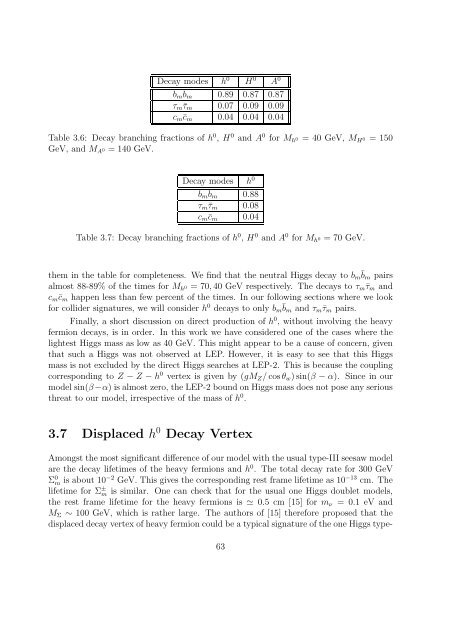PHYS08200604017 Manimala Mitra - Homi Bhabha National Institute
PHYS08200604017 Manimala Mitra - Homi Bhabha National Institute
PHYS08200604017 Manimala Mitra - Homi Bhabha National Institute
You also want an ePaper? Increase the reach of your titles
YUMPU automatically turns print PDFs into web optimized ePapers that Google loves.
Decay modes h 0 H 0 A 0<br />
b m¯bm 0.89 0.87 0.87<br />
τ m¯τ m 0.07 0.09 0.09<br />
c m¯c m 0.04 0.04 0.04<br />
Table 3.6: Decay branching fractions of h 0 , H 0 and A 0 for M h 0 = 40 GeV, M H 0 = 150<br />
GeV, and M A 0 = 140 GeV.<br />
Decay modes h 0<br />
b m¯bm 0.88<br />
τ m¯τ m 0.08<br />
c m¯c m 0.04<br />
Table 3.7: Decay branching fractions of h 0 , H 0 and A 0 for M h 0 = 70 GeV.<br />
them in the table for completeness. We find that the neutral Higgs decay to b m¯bm pairs<br />
almost 88-89% of the times for M h 0 = 70,40 GeV respectively. The decays to τ m¯τ m and<br />
c m¯c m happen less than few percent of the times. In our following sections where we look<br />
for collider signatures, we will consider h 0 decays to only b m¯bm and τ m¯τ m pairs.<br />
Finally, a short discussion on direct production of h 0 , without involving the heavy<br />
fermion decays, is in order. In this work we have considered one of the cases where the<br />
lightest Higgs mass as low as 40 GeV. This might appear to be a cause of concern, given<br />
that such a Higgs was not observed at LEP. However, it is easy to see that this Higgs<br />
mass is not excluded by the direct Higgs searches at LEP-2. This is because the coupling<br />
corresponding to Z − Z − h 0 vertex is given by (gM Z /cosθ w )sin(β − α). Since in our<br />
model sin(β−α) isalmost zero, the LEP-2 boundonHiggs mass does not pose any serious<br />
threat to our model, irrespective of the mass of h 0 .<br />
3.7 Displaced h 0 Decay Vertex<br />
Amongst themost significant difference ofour model with theusual type-III seesaw model<br />
are the decay lifetimes of the heavy fermions and h 0 . The total decay rate for 300 GeV<br />
Σ 0 m is about 10 −2 GeV. This gives the corresponding rest frame lifetime as 10 −13 cm. The<br />
lifetime for Σ ± m is similar. One can check that for the usual one Higgs doublet models,<br />
the rest frame lifetime for the heavy fermions is ≃ 0.5 cm [15] for m ν = 0.1 eV and<br />
M Σ ∼ 100 GeV, which is rather large. The authors of [15] therefore proposed that the<br />
displaced decay vertex ofheavy fermioncould beatypical signatureoftheoneHiggstype-<br />
63
















